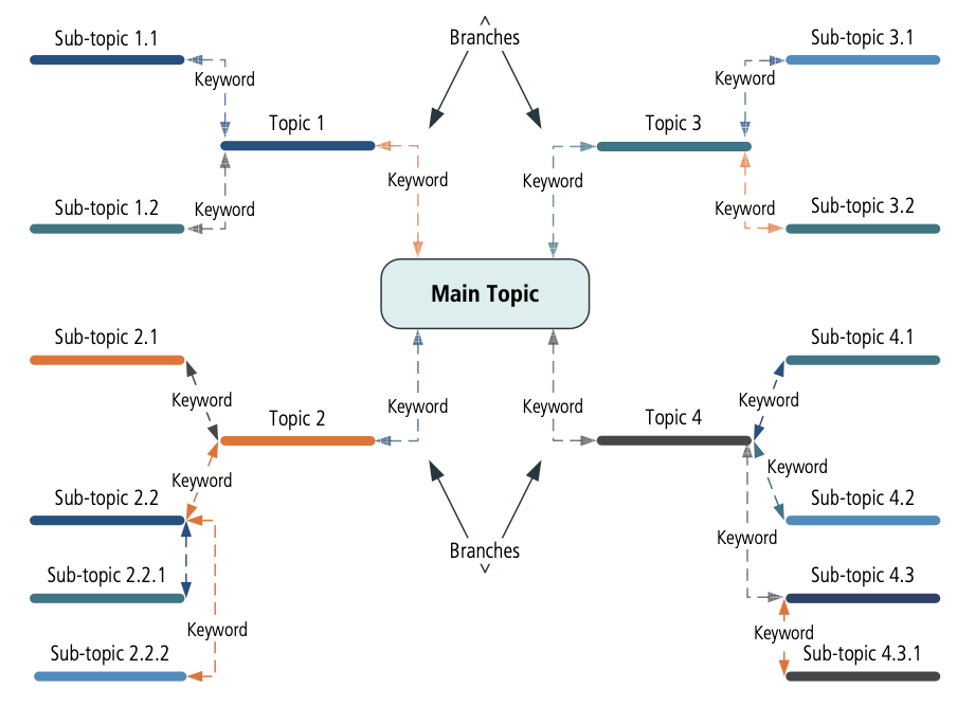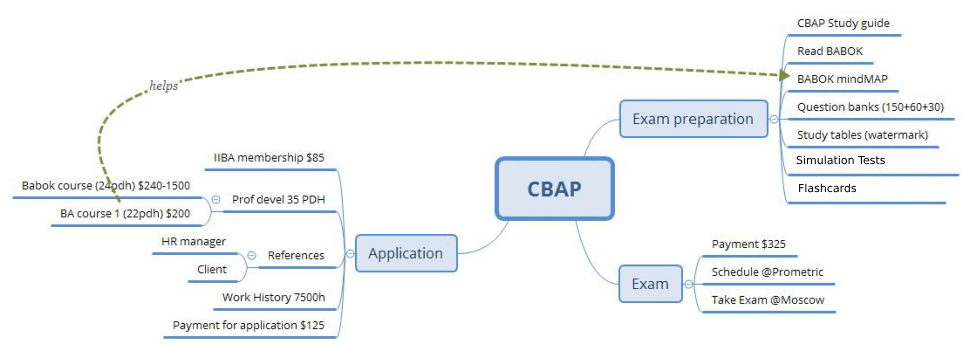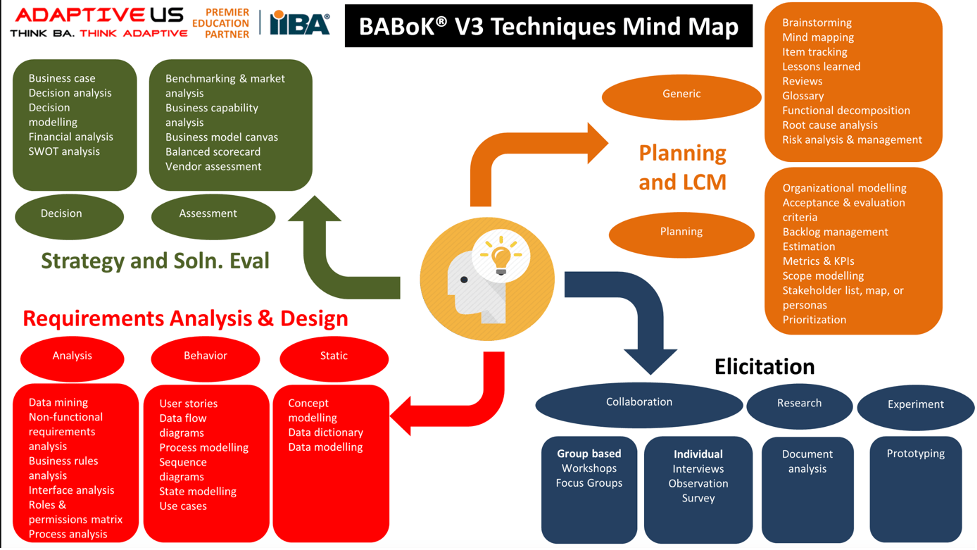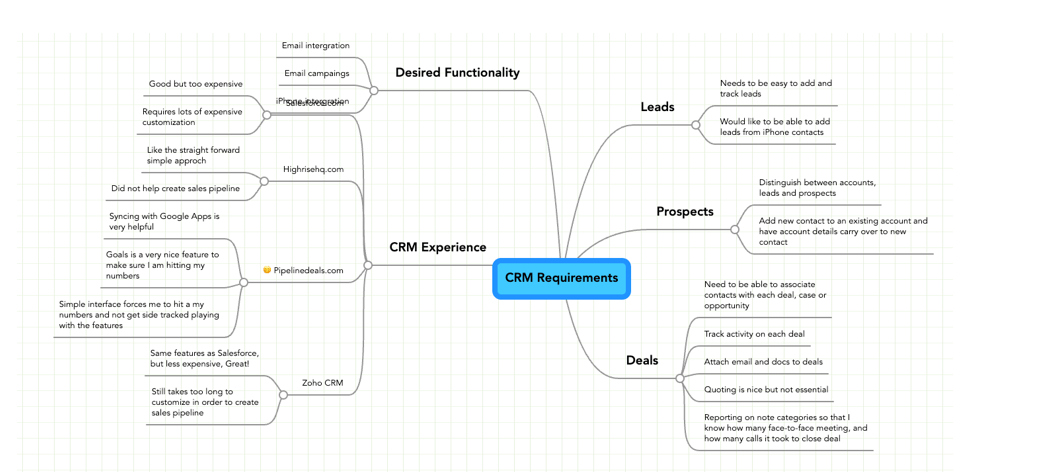In a world filled with information overload and complex ideas, the mind map technique emerges as a powerful tool for simplifying, organizing, and unlocking creativity. BABoK defines mind mapping as a form of note-taking that captures thoughts, ideas, and information in a non-linear diagram. Using images, words, colors, and arrows, this technique allows us to capture thoughts and concepts.
Mindmaps help us:
- To decompose complex topics into simpler ideas.
- To determine how various topics or ideas are related.
- To explore details of an issue, a problem, or a knowledge area.
- To present a comprehensive view of a complex topic.
- To think through large issues with various components.
BABoK Mindmap components and taxonomy terminology

As your experience with the mind mapping technique progresses, you will be able to use it in three types of situations:
Usecase 1. Organize.
First of all, mindmaps are so powerful because they reflect the way our brain stores information. Our brain doesn’t store tables and very nicely refined texts. The pieces of information like words, images, and feelings are stored in a tied manner or related to each other as a very complex network. Sometimes, to remember something, you need to remember something else that pulls the memory of something you’re trying to remember.
By organizing your thoughts in a mindmap, you help your brain to organize your memories. This ultimately helps you to remember a lot of things. No wonder that mind mapping is a great study tool.
I would like to encourage everyone to do the following. Next time you participate in a lecture or a meeting when someone presents a somewhat complex idea or question, try to build a mindmap:
- Start with the main topic or problem as a balloon in the center.
- As the lecturer elaborates on a problem, draw subtopics or key points connected to the main balloon in the center.
- Capture each key point's subpoint, ideas, or parameters as a subpoint in any format or shape that seems relevant to you.
- As the lecture progresses, add arrows and lines connecting various points and use a single verb or noun explaining that connection.
- If you have a different color available, use it to separate branches or to add additional meaning to different topics or subtopics.
Mindmap from my CBAP preparation in 2017

Usecase 2. Present.
Mind mapping is effective for studying, and its effectiveness also extends to enhancing presentations. When presenting, your goal is to make people understand something and not hopefully forget it 5 minutes after the meeting is over. By laying out a beautifully organized mindmap, you’re helping people to remember the idea you’re presenting.
Mindmap presentation allows you to navigate easily and quickly between different subpoints by providing a helicopter view of a problem.
Here’s an example of BABoK techniques presented as a mind map under different knowledge areas by Adaptive US:

Usecase 3. Collaborate.
In spite of the fact that BABoK suggests that mind maps can be developed individually or as collaborative exercises, many people still view it predominantly as a form of studying or memorizing. But once you master your mind mapping skill to the point where you can confidently draw a mindmap, you take this technique to the next level – collaboration!
Mind mapping's power isn't limited to studying, organizing, and presenting; it's also a powerful tool for collaboration and tasks like requirement elicitation. As you draw a mindmap together with your stakeholders, you not only ensure that your requirements are properly structured, but you’re also making sure that not a single requirement is missed.
If you haven’t done mind mapping before, I highly recommend and encourage you to use it, at least for your personal study tool. There are a lot of free software available (such as Xmind or MindMeister) that provide ease of use and storage for working with mindmaps on your laptop, phone, or in the cloud.
In short, mind maps are more than just colorful diagrams; they are tools for unlocking our cognitive potential. They empower us to think critically, solve problems, and communicate ideas effectively.
Help your brain; start using Mindmaps.
You May Also Like
These Related Stories

Essential Techniques Every Data Analyst Should Master

Mastering the Business Analyst Role


No Comments Yet
Let us know what you think